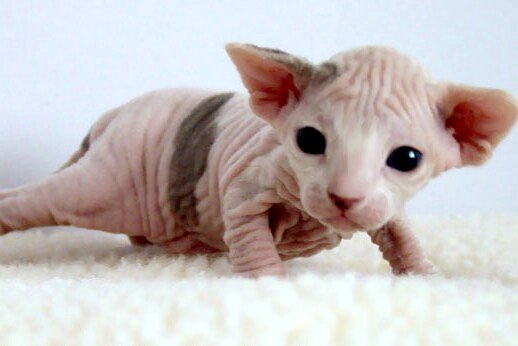One of the tiniest felines also has the largest eyes of any cat breed. The Singapura is The International Cat Association’s (TICA) smallest registered cat breed, having originated on the streets of Singapore. It is best known for its expressive, large eyes and affectionate, playful personality. Cats’ pupils change size and shape in response to light and emotion. They’re usually vertical and shaped like slits, indicating that they’re content and relaxed. When a cat is excited and about to pounce, its pupils become round and large.
Each breed of cat, like every other feature, has slightly different characteristics. Some cats have small eyes, while others have large, one-of-a-kind windows into their soul. Just as humans with large eyes are thought to be more attractive, so is a cat with large eyes. Indeed, many animals with large eyes are thought to be cuter and more adorable. As a result, it’s no surprise that many aspiring pet parents want to know which breeds have the biggest eyes you can’t help but fall for. You’ll not be surprised if some of them are listed as one of the most expensive cat breeds in the world on other posts because truly these amazingly featured companions are really one of a kind. Here are cat breeds with large distinctive eyes:
1. Cornish Rex
The Cornish Rex is a domestic cat breed that originated in Cornwall, England. Most cat breeds have three types of hair in their coats: outer fur or “guard hairs,” a middle layer called “awn hair,” and down hair or undercoat, which is very fine and about 1 cm long. Cornish Rexes have only the undercoat. They are prone to hair loss, with many developing a very thin coat or even going bald over large areas of their body. Their fur curls due to a different mutation and gene than that of the Devon Rex.
Because of their sleek appearance and galloping run, the breed is sometimes referred to as the Greyhound of cats. These cats tend to remain playful and kittenish throughout their long lives. Some Cornish Rexes enjoy playing fetch, racing other pets, and performing acrobatic jumps. They are adventurous and intelligent cats that are adaptable to new situations and will go wherever they can. The Rex is extremely curious, they enjoy human company, and are friendly to other companion animals.
2. Devon Rex
This breed of cat is widely accepted to have originated in the Devonshire region of England in 1960. A domestic short-haired female cat mated with a stray tom cat with an unusual curl in his coat. The resulting litter produced one curly-coated kitten named Kirlee because of his distinctive fur.
The Devon Rex’s wide-set eyes and triangular ears will catch your attention, but its playful antics and sociable nature will steal your heart. Apart from their striking facial features, these small cats have a thin, wavy coat that comes in a variety of colors and patterns. These cats, which arose from a natural mutation in the early 1960s, have been described as out-of-this-world for both their appearance and behavior appearances and antics.
3. Singapura
Though there is some debate about how the Singapura came to be, it is widely assumed that these cats originated on Singapore’s streets. The Singapura was introduced to the United States in the 1970s by Hal and Tommy Meadow, who began breeding these striking felines into purebred cats. The Cat Fanciers’ Association (CFA) recognized the Singapura in 1982 and allowed it to compete in 1988.
The Singapura, or Pura, is the smallest domestic cat breed and is known for its unique appearance and loving personality. When fully grown, this breed weighs only 4 to 8 pounds and has large, round eyes, large ears, and a sepia-colored coat. These purebred felines, which were once common street cats in Singapore, are now prized pets.
4. Sphynx
The modern Sphynx cat differs from Russian hairless cat breeds such as Peterbald and Donskoy. Although hairless cats have been documented throughout history, European breeders have been working on developing the Sphynx breed since the early 1960s. Two distinct groups of hairless felines discovered in North America in the 1970s served as the foundation cats for the current Sphynx breed. Sphynx is known for its outgoing personality. They are highly energetic and curious intelligent creatures. They are able to show love for their owners. In fact, they are listed as fifth among Australia’s Favorite Cat Breeds which portrays one of the more dog-like cat breeds, frequently greeting their owners at the door and being friendly to strangers.
5. Persian
The Persian cat’s ancestors were imported from Khorasan, Persia, into the Italian Peninsula in 1620 by Pietro della Valle, and from Angora, now Ankara, Ottoman Turkey, into France around the same time by Nicolas-Claude Fabri de Peiresc. The Khorasan cats were grey, while the Angora cats were white. They arrived in the United Kingdom relatively quickly after leaving France. In English-speaking countries, it is also known as the “Persian Longhair.” The first documented ancestors of Persian cats were imported into Italy from Persia around 1620. Since the late nineteenth century, Persian cats have been widely recognized by the cat fancy, first by the English, and then primarily by American breeders after World War II. The Himalayan and Exotic Shorthair are considered variants of this breed by some cat fancier organizations, while others treat them as separate breeds. Breeders’ selective breeding has resulted in the development of a wide range of coat colors, but it has also resulted in the creation of increasingly flat-faced Persian cats. This head structure is popular among fanciers, but it can cause several health issues.
6. Scottish Fold
Susie, a white barn cat found in 1961 near Coupar Angus in Perthshire, Scotland, was the first Scottish Fold. Susie’s ears had an unusual fold in the middle, giving her the appearance of an owl. When Susie had kittens, two of them had folded ears, and one was taken in by William Ross, a neighboring farmer, and cat enthusiast. Ross registered the breed with the Governing Council of the Cat Fancy (GCCF) in the United Kingdom in 1966 and began breeding Scottish Fold kittens with the help of geneticist Pat Turner. In the first three years, the breeding program produced 76 kittens, 42 with folded ears and 34 with straight ears. This led to the conclusion that the ear mutation is because of a simple dominant gene.
The Scottish fold’s ears, which appear to fold over and lay flat against the head, maybe its most distinguishing feature. Not to be overlooked is the Scottish fold’s rounded, large eyes, which, along with its ears, give these cats a uniquely cute appearance. Copper, gold, blue, and green are common Scottish fold eye colors. They have a distinctively well-rounded shape. The eyes are separated by the broad nose in the center of the face.
7. Burmese
Most modern Burmese are descended from Wong Mau, a female cat brought from Burma to America in 1930 and bred with American Siamese. From there, American, and British breeders created distinctly different Burmese breed standards, which is unusual in the world of pedigreed domestic cats. The two are not formally recognized as separate breeds by most modern cat registries, but those that do refer to the British type as the European Burmese. Large round eyes in glowing green or gleaming gold are another feature shared by all Burmese cats.
8. Tonkinese
Tonkinese-like cats are thought to have existed in the West since at least the early nineteenth century. The American Burmese type’s founder, a female named Wong Mau who was imported to the United States in 1930, is thought to have been a genetic crossbreed of this type.
If you look into the eyes of a Tonkinese cat, you might not be able to look away. These cats have exotic eye colors such as aqua, sky blue, violet, and gold in addition to large, rounded eyes. The breed evolved from a cross between the Burmese and the Siamese, both of which have distinctive coat colors and diverse genes. This heritage gives the Tonkinese big, colorful, and distinct eyes.

